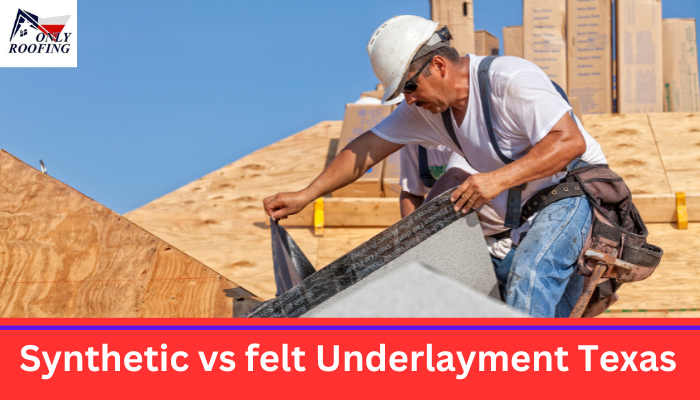Many homeowners are only considerate about the thin outer layer of roofing while planning to restore, replace, or install new shingles from scratch. If you’re living in the Lone Star State and swinging between conventional asphalt shingles and metal shingles, it might make you forget about the importance and difference in synthetic vs felt underlayment Texas. Sometimes, you may not even consider underlayment, which is where the root cause of the problems may arise. But there’s no need to worry because our roofing services Texas are right at your doorstep!
Roof shingles are sandwiched between the roof sheathing, also known as the roof deck. Most often, it is made of plywood decking or Oriented Strand Board (OSB) and the underlayment. The roof deck is put first, followed by the underlayment, which is set immediately on top. It provides extra weather protection and absorbs moisture penetration that your roof is prone to.
Classification of Roof Underlayment
It is necessary to understand the difference between synthetic vs felt underlayment Texas so you can easily decide which variant would prove to be the best for your residential or commercial roof.
Roof underlayment is also referred to as ‘felt paper’ or ‘ice and water shield.’ It is classified into two types, which are as follows: felt underlayment and synthetic underlayment.
Let’s go through a quick guide on synthetic vs felt Underlayment Texas to assist you in making the right decision for appropriate installation.
Felt Underlayment
For almost a century, traditional felt paper has been applied in most residential and industrial roofing systems, and its material composition has remained drastically unaltered. As felt paper is made of recycled substances, it’s considered an eco-friendly solution. It is likewise pretty challenging and can survive harsh weather conditions.
Synthetic Roof Underlayment
Artificial underlayment is probably more expensive than felt. Besides, it is a brand-new product within the production panorama; therefore, there may be little evidence of its long-term performance.
Synthetic vs felt Underlayment Texas
For many years, asphalt-felt roof underlayment has been the industry standard, while synthetic roofing underlayment has gained popularity in recent years due to its improved performance and efficient longevity.
Now that you know the primary distinguishing factors between Synthetic vs felt Underlayment Texas, it would be easier for you to judge the most suitable version of underlayment for your home based on their individualized benefits, which are mentioned below:
Benefits of Synthetic Roof Underlayment
- Because synthetic roofing underlayment is lighter than asphalt felt, it is less complicated to work with and much less likely to cause roof deck damage at some stage in installation.
- It is more resistant to ripping in high winds and punctures than asphalt felt, making it ideal for regions prone to foot traffic or different types of mechanical damage.
- When exposed to harsh climates, synthetic layering is more resistant to UV radiation. Because of this, it will not degrade as unexpectedly as traditional felt paper.
- If properly built, synthetic roofing underlayment is more breathable than asphalt-soaked felt underlayment, allowing moisture to escape from the roof deck and reducing condensation accumulation that may cause roof leaks.
- It is available in various colors, making it easy to customise the colour of your roof shingles.
- This underlayment has an extended lifespan than asphalt felt paper, requiring much less replacement.
- Because synthetic roofing underlayment is recyclable, it is an green model of asphalt felt.
Benefits of Felt Roof Underlayment
- This kind of felt ice and water defend is regularly the foremost desire for roofing specialists and owners alike due to the fact:
- It has an extended shelf life compared to the synthetic variations, which can be manufactured from various substances, including plastic, rubber, and fiberglass. These substances are much less resilient than felt and are more prone to wear and tear during roof production.
- Felt paper is greater proof against wind-pushed rain and ice dams. It is more successful than synthetic underlayment in stopping water leaks, making it a better opportunity for places liable to intense climate.
- Felt underlayment is easier to install because they can be easily attached with staples or nails.
Conclusion
After this discussion, you should now be able to choose between synthetic vs felt underlayment Texas because it is one of several critical roofing elements that make up your overall roofing system. However, there is no one-size-fits-all option for roofing underlayment. Our experts help you choose the appropriate type of underlayment for your project, which is determined by a variety of criteria, including the environment, roofing material, and budget. You can also avail of Only Roofing’s services for roof replacement Woodlands.
Read More:
can you overlap metal roofing lengthwise
how long do thatched roofs last

